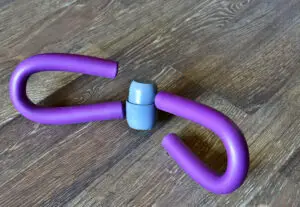Creatine is a naturally occurring compound that plays an essential role in providing energy to the muscles. It is commonly used as a dietary supplement by athletes, bodybuilders, and fitness enthusiasts to enhance strength, muscle growth, and overall athletic performance.
However, some users may experience an undesirable side effect called creatine bloating.
Creatine bloating refers to the short-term water retention and weight gain that some people may experience when supplementing with creatine. This bloating occurs due to the creatine’s ability to draw water into the muscle cells, causing them to swell.
While creatine bloating can be uncomfortable, it is important to note that it is not a sign of actual fat gain and does not detract from the many benefits of creatine supplementation.
To minimise or avoid creatine bloating, there are several strategies that can be implemented. These include taking the correct amount of creatine, drinking adequate water, combining creatine with carbohydrates, and choosing the right type of creatine.
Implementing these tips can help ensure an optimal experience with creatine supplementation, without the discomfort of bloating.
Understanding Creatine and Its Role
Creatine is a naturally occurring substance in the body, primarily produced from amino acids arginine, glycine, and methionine. The liver, pancreas, and kidneys work together to create approximately 1-2 grams of creatine daily, which is mainly stored in skeletal muscles.
Acting as an energy source for muscles, creatine plays a vital role in the production of adenosine triphosphate (ATP). ATP serves as the primary energy currency in cells, helping muscles contract and perform physical activities. By increasing the availability of ATP, creatine effectively supports muscle endurance, strength, and growth.
Adequate creatine levels are essential for maintaining optimal muscle function and overall physical performance. While natural production occurs in the body, dietary sources such as red meat and fish can also contribute to creatine levels. Additionally, many athletes and gym enthusiasts choose creatine supplements to further enhance their performance and muscle growth.
However, an excessive intake of creatine may lead to creatine bloat. This condition is primarily caused by water retention, as creatine molecules attract water. Excess water brought into the muscles can lead to bloating or a feeling of fullness and discomfort.
To avoid creatine bloat, it is essential to:
- Consume the right amount of creatine: Stick to the recommended dosage provided by the supplement manufacturer or consult with a healthcare professional.
- Stay hydrated: Adequate water intake can help the body maintain proper fluid balance, thus preventing water retention and bloating.
In summary, creatine is a crucial component for maintaining muscle health and physical performance, derived from both natural bodily processes and dietary sources. However, one must be cautious of excessive creatine intake to prevent creatine bloat, ensuring that proper dosage and hydration are implemented.
What is Creatine Bloat?
Creatine bloat refers to the bloating or water retention that some individuals may experience when taking creatine supplements.
Creatine is a naturally occurring compound in the body, primarily produced in the liver, kidneys, and pancreas from amino acids arginine, glycine, and methionine. It is commonly used by athletes and fitness enthusiasts to enhance muscle size, strength, power, and performance.
The bloating is primarily caused by water retention, which occurs due to an excess intake of creatine. Creatine molecules attract water, and taking too much creatine can cause an excess of this water to be retained in the body, leading to bloating.
In some cases, this water retention might also contribute to a temporary weight gain. While creatine bloating might not pose a significant health risk for most people, it can be uncomfortable and potentially affect one’s appearance and confidence.
To avoid creatine bloat, it is recommended to take the appropriate amount of creatine and stay well-hydrated. Ensuring consistent water intake can help regulate the balance of water in the body and prevent bloating.
Moreover, gradual introduction of creatine supplements to one’s diet, often referred to as creatine loading, can also help in minimising bloating as the body adapts to the increased creatine levels.
It is crucial to follow the recommended dosages and consult with a healthcare professional or a nutrition expert if uncertain about the appropriateness of creatine supplementation.
Maintaining a balanced diet, engaging in regular physical activity, and monitoring one’s overall health can further contribute to minimising the risk of creatine bloat and promoting a positive experience with creatine supplementation.
The Connection Between Creatine Bloat and Supplements
Creatine is a naturally occurring compound that plays a crucial role in providing energy to muscles during high-intensity activities. To enhance their performance, athletes and fitness enthusiasts often opt for creatine supplementation, with creatine monohydrate being the most popular form of creatine in the market.
The bloating associated with creatine supplementation is typically due to water retention within the muscle cells. As creatine increases its concentration in the muscles, more water is drawn into the cells, leading to a temporary increase in both muscle size and weight. This phenomenon can create a bloating sensation or even a visibly puffed appearance.
Although creatine bloating is not harmful, it can be uncomfortable for some individuals. To minimise or avoid this issue, consider taking some of the following steps:
- Choosing a different form of creatine: Creatine monohydrate is the most researched and widely available form, yet many alternatives have emerged on the market. Some individuals may find that they experience less bloating with a different form, such as creatine hydrochloride or micronised creatine.
- Lower the dosage: Decreasing the daily intake of creatine may help to alleviate bloating. The standard recommendation is to consume 5 grams per day, but reducing the amount to 3 grams might be beneficial for those who are sensitive to the effects of creatine on water retention.
- Stay hydrated: Ensuring adequate water intake is essential while taking creatine supplements. Staying hydrated can help to regulate the distribution of water in the body, subsequently reducing the risk of bloating.
- Cycle creatine intake: Some people may benefit from cycling their creatine supplementation, alternate between periods of consumption and cessation. This approach can help to maintain the positive effects of creatine on performance while minimising bloating.
In conclusion, creatine bloat is primarily due to increased water retention in muscle cells when supplementing with creatine. Choosing a different form of creatine, lowering the dosage, staying hydrated and cycling creatine intake are potential strategies for reducing the risk of bloating.
With a careful approach, individuals can reap the benefits of creatine supplementation while minimising unwanted side effects, such as bloating.
Methods to Prevent and Avoid Creatine Bloat
Creatine bloat is a common concern among individuals who supplement with creatine to enhance their athletic performance. This bloating, as the name suggests, refers to the water retention that occurs in muscles when taking creatine. However, there are several strategies to effectively prevent and avoid creatine bloat.
One key method in preventing creatine bloat is maintaining proper hydration. Since creatine attracts water to muscle cells, it is crucial to increase water intake when consuming creatine supplements.
Ensuring adequate water intake will help maintain a healthy balance of water in the body, avoiding the unnecessary water retention that causes bloating.
Being mindful of one’s diet is also an essential factor in avoiding creatine bloat. Cutting down on bloat-inducing foods, such as those high in sodium, refined sugars, and processed carbohydrates, can help minimise water retention. Incorporating potassium-rich foods, like bananas, sweet potatoes, and avocados, may aid in balancing the body’s water levels.
Exercise plays a crucial role in reducing creatine bloat. Implementing a consistent workout routine ensures that the creatine is utilised effectively within the muscles for energy and strength, thus reducing the potential for water retention. Aerobic exercises, in particular, can help minimise bloating by promoting healthy blood circulation and lymphatic drainage.
Another suggestion to prevent creatine bloat is to avoid the loading phase. The loading phase refers to taking high doses of creatine during the initial days of supplementation, a practice that can trigger bloating in some individuals. Instead, opt for a lower dosage from the beginning, allowing the body to adjust gradually to the supplement without causing water retention issues.
By focusing on hydration, diet, exercise, and appropriate creatine intake, individuals can successfully prevent and avoid creatine bloat. Ensuring these measures are consistently maintained will allow for the safe and effective use of creatine, enhancing athletic performance without the uncomfortable side effects of bloating.
Dosage and Usage – Loading Phase, Maintenance Dose, and High Doses
Creatine is a popular supplement commonly used by athletes and gym-goers to enhance their performance and build muscle. To get the most out of creatine, it is essential to follow the recommended dosage and usage guidelines. This section will discuss the loading phase, maintenance dose, and high doses of creatine.
The loading phase is the initial stage of creatine supplementation and aims to rapidly saturate the muscle stores with creatine. This phase usually lasts for 5-7 days, during which high doses of creatine are consumed.
The typical dosage during this period is 20 grams per day, divided into four daily servings of 5 grams each. The loading phase results in quicker benefits of creatine, such as increased exercise performance and muscle growth.
Following the loading phase, the maintenance dose is implemented to maintain saturated muscle stores. The maintenance dose is significantly lower than during the loading phase and typically ranges from 3 to 5 grams per day. This dosage can be maintained for several weeks or months, depending on the individual’s exercise goals and needs.
Some users opt for high doses of creatine, which entails consuming more creatine than the recommended maintenance dose. While this approach could potentially enhance the benefits of creatine further, it might also lead to side effects such as creatine bloating.
Creatine bloating occurs when excess water is retained within the muscles, leading to a feeling of fullness and puffiness.
To avoid creatine bloating and potential side effects, it is crucial to adhere to the recommended dosage guidelines and ensure adequate hydration while using creatine supplements.
If creatine bloating persists despite these precautions, consider consulting a healthcare professional or a trusted sports nutrition expert for personalised advice.
Effects of Creatine on Training and Athletic Performance
Creatine is a popular supplement among athletes, bodybuilders, and fitness enthusiasts due to its potential to enhance training performance and improve exercise outcomes.
It is a molecule stored in muscles that helps create energy, and it plays an essential role in providing fuel for high-intensity exercises such as sprinting, lifting, and bodybuilding workouts.
Research shows that supplementing with creatine can lead to a 5-15% increase in strength and athletic performance.
This substance is especially beneficial for activities that involve short bursts of high-intensity efforts, as it can help replenish the body’s energy stores more quickly and efficiently. As a result, athletes and exercisers can maintain high-intensity workouts for longer periods, potentially leading to greater gains in strength, power, and overall performance.
However, creatine’s benefits are not limited to only power and strength-based activities. Some studies suggest that it may also provide advantages for endurance activities, such as running. Research on creatine’s ergogenic effects consistently reveals positive outcomes in improving exercise adaptations, which can potentially benefit athletes across various sports and activities.
To get the most out of creatine supplementation, individuals should start with a loading phase, typically involving the intake of 20 grams of creatine daily for 5-7 days. Following the loading phase, a maintenance dose of 3-5 grams per day should be sufficient to maintain the body’s creatine stores and aid in training performance.
It is important to note that proper hydration is essential when supplementing with creatine, as dehydration can increase the risk of developing muscle cramps or gastrointestinal discomfort.
Maintaining a balanced diet and following an appropriate training regime are also crucial aspects of maximising the potential benefits of creatine supplementation.
Creatine’s Effect on Muscle Growth and Strength
Creatine is a naturally occurring substance in our bodies, primarily produced in the liver, kidneys, and pancreas. It helps our muscles produce energy during heavy lifting and high-intensity exercise, making it an essential component for enhancing athletic performance.
The popularity of creatine supplementation stems from its ability to improve muscle mass and strength when combined with regular strength and resistance training.
One of the main benefits of creatine lies in its ability to increase the availability of adenosine triphosphate (ATP), the primary energy source for our muscles during activities that require quick bursts of power. This leads to better performance levels and helps individuals engage in more intense workouts, thereby stimulating muscle growth.
Aside from enhancing muscle strength, creatine has been observed to promote the increase in lean muscle mass. This is due to the fact that creatine supplementation can cause an increase in water content within the muscle cells, leading to a temporary increase in muscle size, also known as cell volumisation.
The presence of additional water can encourage the muscles to work for longer periods and allow for faster muscle recovery after intense training sessions.
Although creatine is mostly associated with power and strength-based exercises, it has potential benefits for endurance athletes as well. For example, some studies suggest that creatine supplementation may aid runners by improving their ability to generate force during high-intensity training sessions, potentially leading to improvements in speed and athletic performance.
To get the most out of creatine in terms of muscle growth and strength, it is crucial to maintain a consistent training routine and follow a protein-rich diet that provides the necessary nutrients for muscle recovery and growth. It is worth noting that although creatine bloat might cause temporary water weight gain, its long-term effects in supporting muscle development far outweigh any short-lived discomfort.
In conclusion, creatine plays a significant role in promoting muscle growth and strength by enhancing energy production, promoting lean muscle mass gains, and acting as a support for recovery and performance in both high-intensity and endurance-based activities.
Side Effects and Safety of Creatine Use
Creatine is a popular dietary supplement commonly used by athletes and fitness enthusiasts to enhance muscle growth, strength, and power. While generally considered safe when consumed in appropriate doses, there are some potential side effects that users should be aware of.
One of the most common side effects associated with creatine use is dehydration. Creatine can draw water into the muscles, which may lead to increased water consumption and a possible risk of dehydration if not managed properly. Ensuring adequate hydration during creatine supplementation is essential to minimise this risk.
In addition to dehydration, some individuals may experience gastrointestinal issues when taking creatine, such as diarrhea or nausea. These side effects are typically more prevalent when consuming high doses of creatine or when it is first introduced into a dietary regimen. To reduce the likelihood of these issues, it is recommended to start with a low dose of creatine and gradually increase it as tolerated.
Creatine and Its Effect on Ageing Process
Creatine is a popular dietary supplement known for its ability to enhance muscle mass and strength, particularly in athletes and fitness enthusiasts. However, its effects extend beyond just improving athletic performance, as it plays a significant role in the ageing process as well.
As individuals age, there is a natural decline in muscle creatine, muscle mass, bone density, and strength.
Numerous studies have been conducted with the aim of understanding the potential benefits of creatine supplementation in older adults. According to research, creatine supplementation in ageing individuals can help increase lean body mass, strength, and enhance fatigue resistance, all of which are particularly important for maintaining an active and healthy lifestyle.
Accumulating evidence from meta-analyses and randomized controlled trials suggests that creatine supplementation may not only contribute to increases in muscle mass and strength in ageing individuals, but also reduce the risk of falls and possibly slow the loss of bone mineral. These benefits can make a considerable difference to the quality of life for older adults, helping them remain more independent and physically capable.
In addition to its potential impact on muscle and bone health, creatine also demonstrates possible anti-inflammatory properties, which can be beneficial during the ageing process. Although the preliminary evidence is limited, this highlights another potential advantage of creatine supplementation for older individuals.
It is important to note that the effects of creatine supplementation may vary among individuals, depending on factors like age, overall health, and fitness levels. Therefore, it is crucial to consult a healthcare professional before starting any supplementation regimen, especially for older adults who may have other age-related health concerns.
In conclusion, creatine supplementation offers promising benefits for ageing individuals, including improvements in muscle strength and mass, reduced risk of falls, and potential anti-inflammatory properties.
By taking a proactive approach towards their health, older adults can potentially improve their overall wellbeing and maintain an active lifestyle with the aid of creatine supplementation.
Types of Creatine: Monohydrate, Buffered Creatine, and Creatine Hydrochloride
Creatine is a naturally occurring molecule in the body, similar to an amino acid, and is also available as a dietary supplement to enhance athletic performance. There are various types of creatine, with the three most popular types being creatine monohydrate, buffered creatine, and creatine hydrochloride.
Creatine monohydrate is the most widely researched and commonly used form of creatine supplement. It is known for its proven effectiveness, safety, and affordability. Creatine monohydrate helps increase strength, power, and muscle mass by recycling adenosine triphosphate (ATP), the primary source of cellular energy. The effectiveness of this form is supported by numerous scientific studies.
Buffered creatine, also known as Kre-Alkalyn, is a patented form of creatine that is claimed to cause less bloating and stomach discomfort than creatine monohydrate. It is made by adding a buffering agent, such as magnesium glycerol phosphate or bicarbonate, to the creatine molecule. This is intended to raise the pH level, making it less acidic and more stable in the stomach.
However, there is limited evidence to support the superiority of buffered creatine over its monohydrate counterpart, and more research is needed to confirm its potential benefits.
Creatine hydrochloride is another popular form of creatine supplement. It is created by attaching a hydrochloride (HCl) group to the creatine molecule. This modification is designed to increase the solubility and absorption of creatine in the body.
While some users report experiencing fewer side effects such as bloating and gastrointestinal issues with creatine hydrochloride, research comparing it to creatine monohydrate is limited. As a result, it is difficult to determine if it is more effective or advantageous.
In conclusion, creatine monohydrate, buffered creatine, and creatine hydrochloride are the three most popular types of creatine supplements.
While creatine monohydrate is the most well-researched and widely used form, buffered creatine and creatine hydrochloride have their own potential benefits. More research is needed to determine if these newer forms can offer better results with fewer side effects.
Latest Research and Studies on Creatine
Recent studies have delved into the effects and benefits of creatine supplementation for various populations. A comprehensive review found that creatine is not only an ergogenic aid for athletes but also an effective supplement in patient populations.
This research indicates that creatine supplementation offers a variety of beneficial effects, including increased anaerobic energy capacity, decreased protein breakdown, and subsequently increased muscle mass and physical performance. These benefits extend beyond athletes, with a positive impact seen in older individuals and those with certain health conditions.
Regarding the issue of creatine bloat, it is important to understand that it may occur due to the initial water retention associated with creatine supplementation. A study on creatine supplementation provides insights into the common misconceptions and sheds light on how to manage this side effect.
To avoid creatine bloating, individuals can try adjusting their dosage and the timing of consumption. Gradual and consistent doses can help minimise water retention, while proper hydration may further alleviate bloating.
In conclusion, the latest research on creatine showcases its numerous benefits for a wide range of populations. As for creatine bloat, it can be managed by paying attention to dosing strategies and maintaining adequate hydration levels.
How Creatine Affects Total Body Water and Muscle Size
Creatine is a popular supplement used by athletes and fitness enthusiasts for improving performance and muscle size. It plays a crucial role in energy production within the muscles, and its supplementation can lead to an increase in strength and athletic performance.
When ingesting creatine, it is important to understand its effect on total body water (TBW) and muscle size.
One of the main effects of creatine is the increase in water retention in the body, particularly within the skeletal muscles. This is because creatine molecules attract water, which can lead to an increase in total body water. A study found that creatine supplementation increased muscle creatine concentration, body mass, and TBW. However, this increase in water weight does not negatively impact fluid distribution in the body.
The increase in total body water contributes to an increase in muscle size, as the muscles appear fuller and more pumped due to the additional water content. While some may perceive this as “creatine bloat”, in many cases, the effect is subtle and not detrimental to one’s physique or performance.
To minimise water weight gain and the risk of bloating while supplementing with creatine, several steps can be taken. Ensuring the appropriate dosage of creatine is consumed prevents excessive water retention. The typical dosage recommendation is 3-5 grams per day.
Staying hydrated is also essential when using creatine, as it promotes proper functioning of the muscles and helps maintain the water balance in the body. Drinking ample amounts of water throughout the day can help prevent unwanted bloating and maintain an optimal hydration status.
In conclusion, creatine supplementation can cause an increase in total body water and muscle size due to its water-attracting properties. This effect is not necessarily negative and can contribute to a fuller and more athletic appearance. By following proper dosage guidelines and ensuring adequate hydration, the risk of creatine bloat can be mitigated.
Conclusion
Creatine bloating is a common concern among individuals who supplement with creatine. It is primarily caused by an increase in water retention within the muscles. To avoid this uncomfortable side effect, there are several strategies one can adopt.
First, ensure that the correct dosage of creatine is being taken. It is generally recommended to consume 3-5 grams of creatine per day. Drinking sufficient water is crucial in helping the body process creatine and reduce bloating. Staying well-hydrated can also prevent potential kidney issues related to creatine supplementation.
Combining creatine with carbohydrates may be beneficial in improving its absorption. Trying a different type of creatine such as creatine hydrochloride or micronized creatine might help in reducing water retention and bloating as well. Skipping the loading phase, which involves consuming a large amount of creatine in a short period of time, can be another effective solution.
Using a reputable brand of creatine is essential for ensuring the quality and purity of the supplement. Avoiding foods known to cause bloating, such as legumes, cruciferous vegetables, and carbonated drinks, can further contribute to preventing creatine bloating.
Adopting these measures can significantly reduce the likelihood of experiencing discomfort and help individuals harness the full benefits of creatine supplementation for improved athletic performance, muscle growth, and recovery.
My name is Ellis Francis and I have been a personal fitness trainer, sports nutritionalist and health and fitness advisor for over 25 years. I am the lead health and fitness advisor at https://awellnessbody.com.







